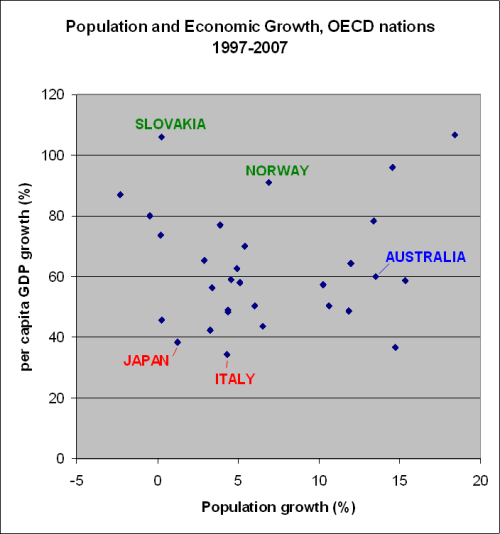But enough of economic models, what about the real world? The Intergenerational Report discusses just two examples: Italy and Japan. Both nations have experienced very low fertility levels, rapidly ageing populations, and slow economic growth in recent decades. On the basis of these two countries, the Intergenerational Report concludes that “A key lesson from the international experience is that countries with low population growth or declining populations such as Japan and Italy face lower potential rates of economic growth than countries with relatively healthier population growth.”
But why focus on those two countries? A broader look across the OECD (see figure 1) shows that rapid population growth is neither necessary nor sufficient to achieve solid per capita GDP growth. (I leave aside here the question of whether per capita GDP growth is a useful goal to strive for, except to say that Joseph Stiglitz and many other mainstream economists have cast doubt on the wisdom of an excessive focus on GDP.)

Advertisement
In fact, no fewer than 11 OECD nations achieved faster per-capita economic growth than Australia from 1997-2007, despite slower population growth or even in some cases no population growth or a slight decline.
Clearly enough, experience shows us that rapid population growth is no guarantee of economic prosperity, and conversely a stable population does not doom a country to economic failure.
The real puzzle here is why the Intergenerational Report discusses only the two worst performing countries among OECD nations on this issue, rather than looking at some of the success stories. Norway looks like an interesting case - thriving economy, despite an ageing population and much lower population growth than Australia. Or how about Slovakia, with a stable and ageing population and a booming economy?
The Netherlands, the Czech Republic, Poland, Hungary, Finland … with so many intriguing examples of countries with stable or low-growth populations that somehow continue to enjoy vibrant economies, it’s a pity the report didn’t take a more lateral approach.
As for the significant environmental, planning and social challenges of population growth, the report acknowledges them but plays them down in a single line of optimism: “The risks in these areas are manageable provided governments take early action to plan for future needs.” Sure, but that’s a pretty big proviso. It’s a bit like saying I can win a marathon, provided I run really fast: technically true, but it really begs the question of how.
Lindsay Tanner similarly suggests that we focus on better planning and less profligacy, rather than worrying about population. One can hardly argue against better planning and lower ecological footprints; they are desperately needed. What is beyond me is how he can be so sanguine about our ability to achieve those ambitious goals, in the face of all evidence that we’re nowhere close to the trajectories required even to reduce the ecological footprint of the present population.
Advertisement
The truth is we are struggling just to catch up with the huge backlog of infrastructure, social and environmental investments for our 22 million people, let alone the 36 million that would present if we continued current migration trends.
A better approach, again, is that provided by the National Population Council in 1991. It said that “Solutions should not be assumed for population-related problems through other policies, unless the institutional and other mechanisms required to effectively implement those solutions are in place”.
The assumption that the impacts of population growth will be defrayed by technological and planning improvements is the opposite of a precautionary approach. It is fine to hope for the best possible outcome, but reckless to pursue policies that will increase our population on the expectation that the best possible outcome will occur. And even more reckless in the face of the facts are that Australia’s per-capita greenhouse pollution continues to increase year on year, our cities continue to push beyond urban growth boundaries, and few of the policies or practices that would signal a transition to a genuinely sustainable lifestyle are in place.
In the end we as a nation have options about our future population. The Intergenerational Report and the government treat us as if we have none, confronting us with a false choice between rapid population growth or economic calamity. The truth is that we can care for an ageing population, enjoy economic prosperity and work towards ecological sustainability without rapid population growth. How? Just ask the Norwegians. Or the Slovaks. Or the Dutch. Or …
Discuss in our Forums
See what other readers are saying about this article!
Click here to read & post comments.
54 posts so far.